Chicken Nesting Boxes – What You Need for Happy Hens
Chicken nesting boxes are for laying eggs and hatching eggs, but what do your hens need to be happy? We'll share tips for building cozy nest boxes, positioning your nests, and having enough space for all your chickens.
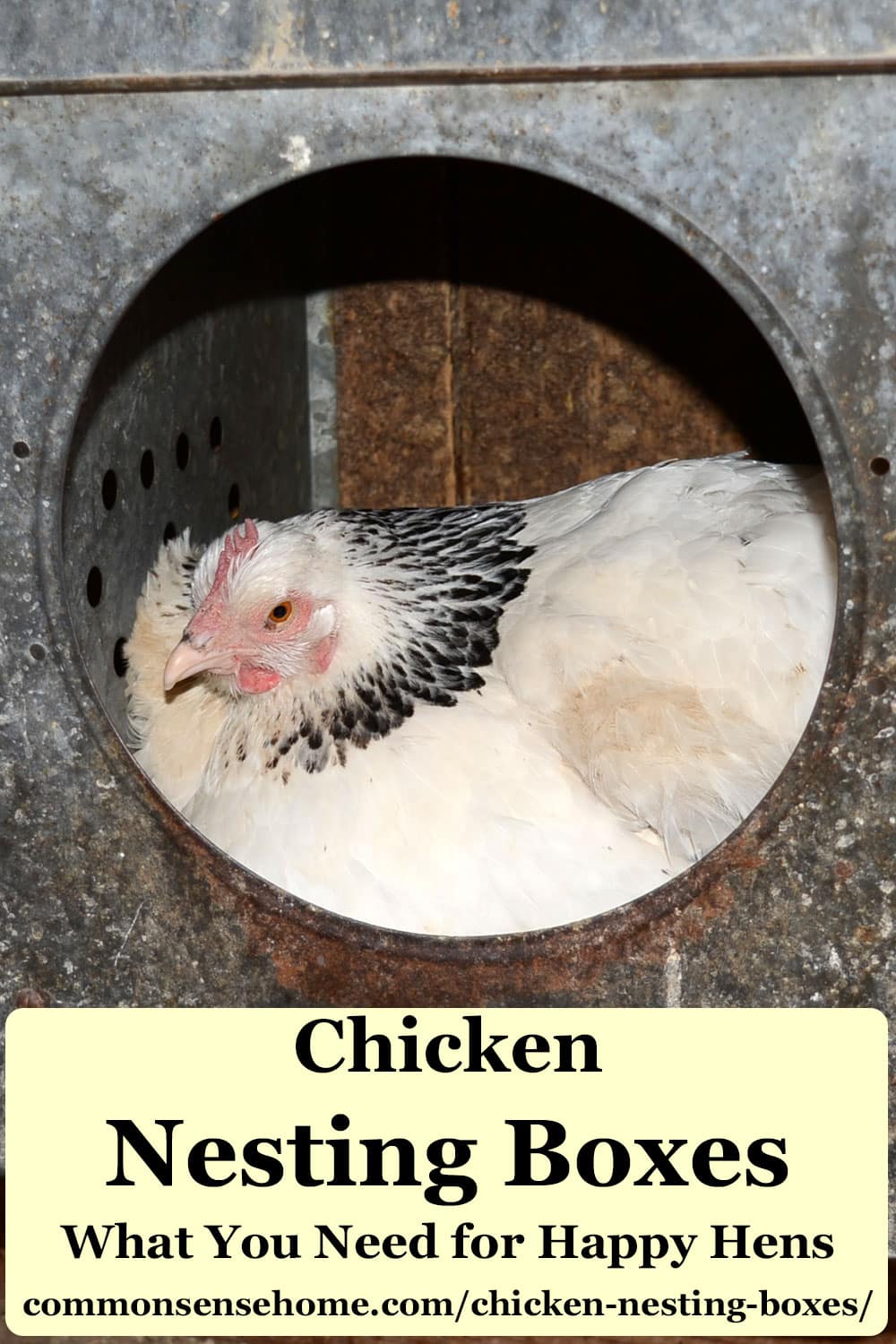
Chicken Nesting Boxes
Chicken nesting boxes serve two purposes – laying eggs and hatching eggs. To encourage your backyard chickens to lay where you want them to, you need to provide for their needs in a nesting box.
See Best Laying Hens- For Beginners, White Eggs, Brown Eggs for hen suggestions, and “When Do Chickens Start Laying Eggs? (And Why They Stop)“.
Sometimes placing fake eggs or golf balls in their nest helps, other times, especially with free range chickens, the girls are determined to hide their eggs. Let's break down what makes a hen feel welcome.

Safe
Your hens need to feel safe in their box in order for them to want to lay eggs.
In their mind, they are laying future generations of chickens, their nest needs to feel like a safe place to lay eggs. This means it should be protected from predators and the elements.
Private
The ideal location for a chicken nesting box is away from lots of traffic. If there is too much commotion going on close to the nesting box, they will either find another place to lay or wait to lay. Neither is an ideal situation.
Chickens also like their own space. While they may all lay eggs in the same box, they don't like to see each other laying at the same time.
Quiet
Knowing how loud and noisy chickens can be may make you laugh to think hens like a quiet space to lay, but they do. Chicken noise (like the egg song) being the exception, of course.
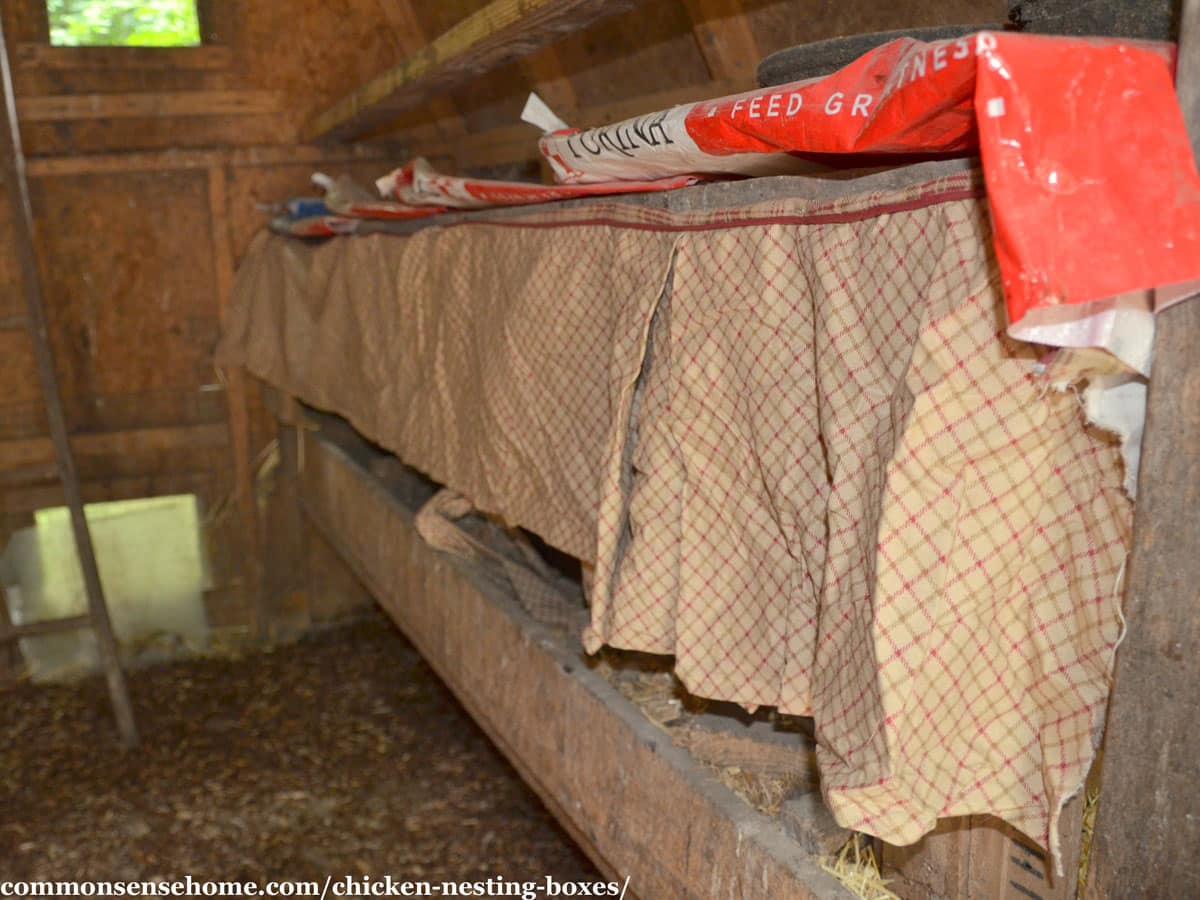
Dim The Lights
Chickens need at least twelve hours of light per day for egg production.
Chickens have a pineal gland, which is found in the brain and is activated by light. Daylight stimulates the gland into secreting the hormones melatonin and serotonin, which in turn guide the hens’ circadian rhythms.
That said, they like a dim location to lay their eggs. If you keep lights on in your chicken coop, you can add some curtains to their nesting boxes to reduce the light for them.
Chicken Nesting Box Size
Standard nesting box size is a 12 inch cube. That's twelve inches high, twelve inches wide, and twelve inches deep.
Bantams, miniature chicken breeds, could use a smaller sized nesting box, while larger breeds such as Jersey Giants or Cochins may need a bigger nesting box.
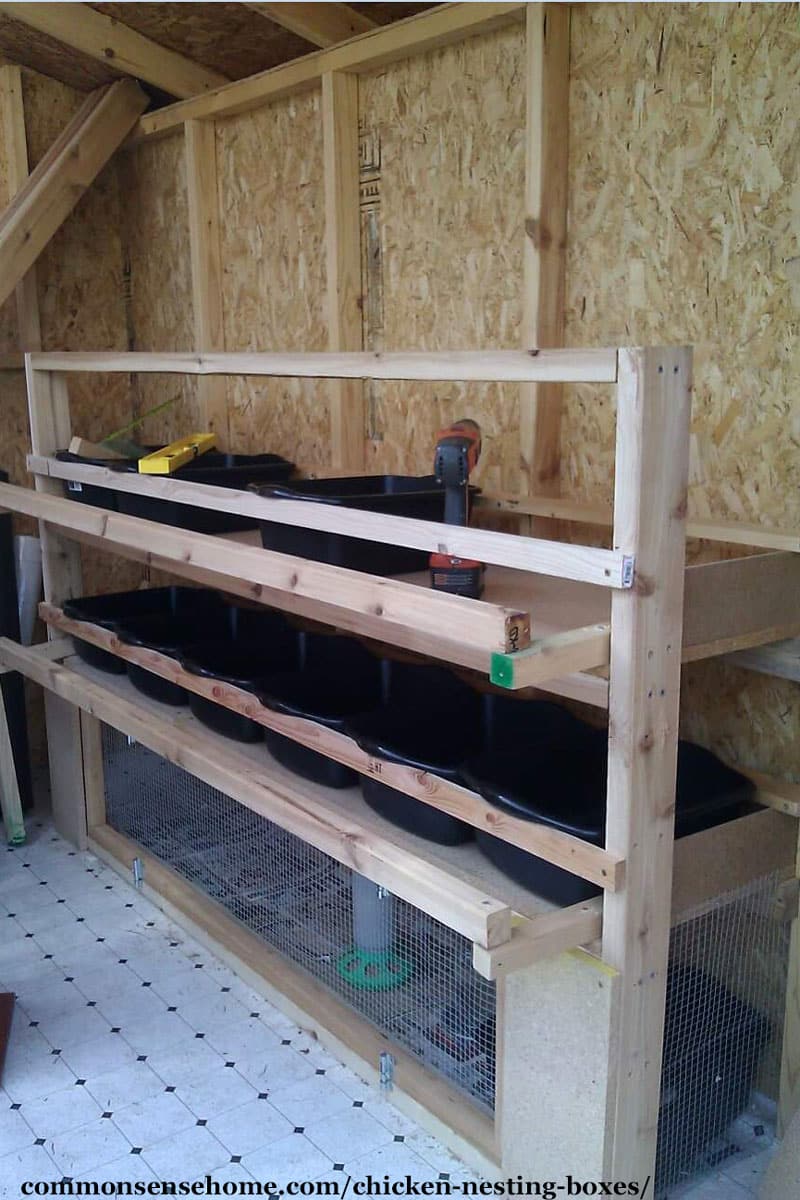
How Many Chicken Nesting Boxes do I Need?
Ideally, you should have at least one nesting box for every four hens. They may still want to lay in just one nesting box – because chickens are silly.
I don't know if they like to play follow the leader, if they're jealous, or if they try to outdo each other.
Failing to provide enough nesting boxes could lead to cracked eggs, egg eating, hens that fight, or hens that won't lay in a nesting box.
If you would like to be certified humane, you are required to provide one nesting box per five chickens. You can find out more about certification from the USDA National Agricultural Library.

Do Chicken Nesting Boxes Need to be Elevated?
Yes, nesting boxes should be elevated off of the ground by at least 1 1/2 – 2 feet. This is to protect your hens while nesting, as well as protect their eggs.
How High do Chicken Nesting Boxes Need to Be?
Nesting boxes should be lower than your highest roosting bars, but higher than your lowest roosting bars. Chickens like to roost, and the ones at the top of the pecking order will pick the highest place in the coop to perch.
If your nesting boxes are the highest place, that is where they will perch – and poop.
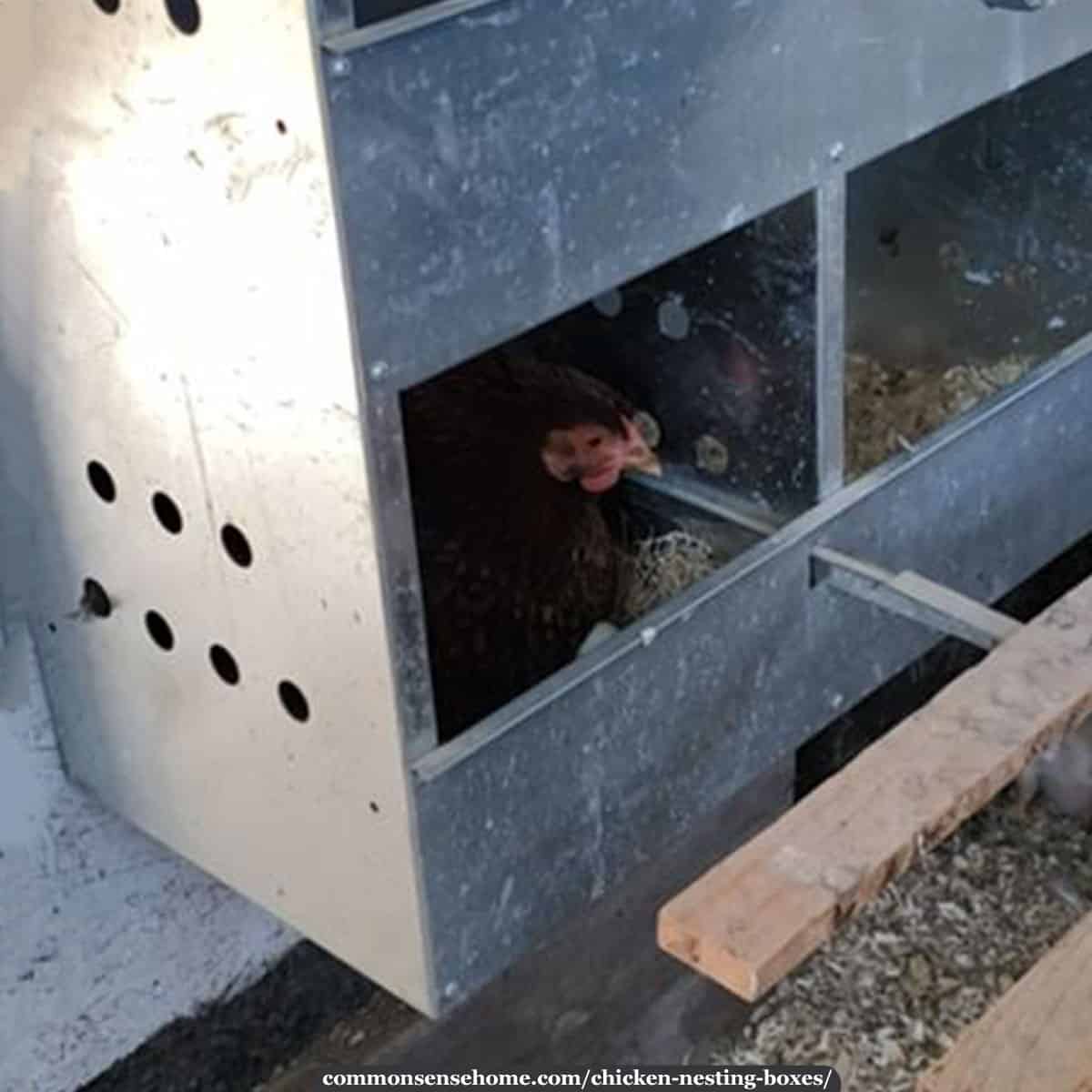
What is Best to Use for Chicken Nesting Boxes?
Chicken keepers get really creative and resourceful when it comes to nesting boxes.
Features you may want to include are:
- Lips on your nesting box to prevent eggs from rolling out or nesting material falling out.
- Ventilation. You can add some ventilation by drilling a couple of holes if you're using a solid container.
- Rear hatch or opening for egg collection.
- Dried herbs added to their nesting box to help with odor, pest and insect control, and provide soothing scents.

You can build your own from nesting box plans you find online, buy them pre-made, or use some of the recycled ideas below.
- Milk Crates
- Food containers
- five-gallon buckets
- Cat litter tubs
- Feed Buckets
- Metal nesting boxes
- Wood
- Planter pots
- Totes
- Dresser drawers
- Storage Containers
If you want a rollaway nest box – one where the eggs roll out from the box for easy picking – you'll need to slightly angle the floor of the box and provide a catch tray.
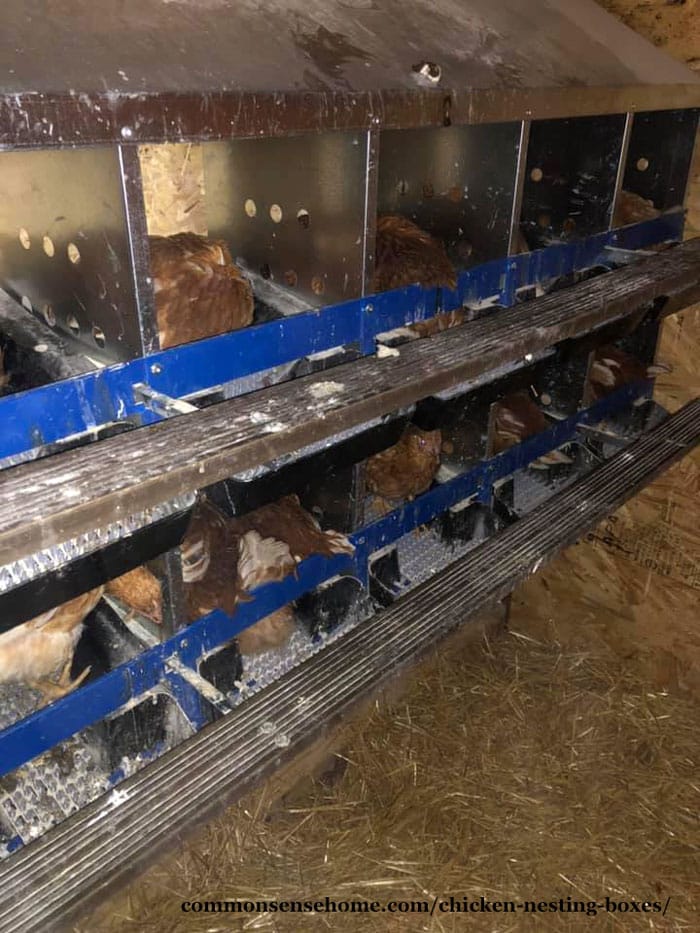
Nesting Materials to Use
Add a layer of nesting material to your nesting boxes and make sure to clean them out often. Ideally, you won't see the bottom of the nesting box when you have an adequate amount of material added.
The cleaner your bedding material, the cleaner your eggs will be. Not to mention, you'll want a soft landing pad for your laying hens. Cracked eggs on feathers aren't a good combination.
- Nesting pads (easy to clean)
- Sand
- Wood shavings
- Straw
- Hay
- Shredded paper (if using newspaper, only use the black and white print, not the shiny ads or colored paper)
- Pine Needles
If you're at the beginning stages of your feathered adventures with raising chickens, you'll appreciate our 7 Best Chicken Tips for First Time Chicken Owners.

We Love Backyard Chickens
There isn't a day that goes by where I'm not excited to go to the nesting box to collect eggs. Even after decades of raising chickens and being around chickens, it never gets old.
It's like a surprise every time, did I get one egg, or enough to fill a whole carton? What colors will I get this time?
Sometimes I open up the box and a hen is on the nest, so I apologize and hurriedly close the box to leave her in peace to do her thing.
For more information on raising chickens, see:
- Quick Lock Chicken Door – Predator Resistant, Easy Latch Open or Closed
- What to Feed Chickens – Do’s and Don’ts for a Healthy Chicken Diet
- How to Raise Chickens Cheaply – Small Budget? No Problem.
- 50 Do-It-Yourself Projects for Keeping Chickens – Chicken Coops and More
- Meat Chickens – Best Breeds, Care and Troubleshooting Tips
- When Do Chickens Start Laying Eggs? (And Why They Stop)

This post is by Amber Bradshaw of My Homestead Life.
Amber and her family live off grid on forty-six acres in the Smoky Mountains in East Tennessee.
Amber is the author of The Beginner's Guide to Raising Goats and Beekeeping for Beginners.

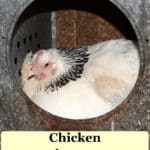
2 questions: My nesting boxes are off the ground by 2ft-3ft. What should I do once eggs hatch? Are they safe in the nesting box that high? Second question will I need to separate the chicks from the current flock? Thank you!
Chicks are pretty durable, so they would probably be okay with the drop, but we usually gather up mom and the babies once all have hatched and move them to a separate pen. They might be okay with the main flock, but chicks are so delicate that the odds are better in a more protected environment. Plus, some hens are very attentive, but others make lousy mothers.
I have the time and space and would enjoy caring for a few chickens, but I can’t handle putting an animal down. If a chick was deformed or a hen was old and stopped laying I wouldn’t be able to do what needed to be done even if it was humane. I don’t know how to overcome this hurdle.
Do you have any friends who could help deal with the tough stuff? Maybe friends who hunt and are used to processing game animals?
Usually you don’t need to take care of things immediately. Deformed chicks can be made comfortable and will normally pass on their own if they are not viable. Hens can be butchered on the friend’s schedule.
when there’s free roosters that someone needs to cull >>> it’s an avalanche of responses on the local “farm” Facebook site for buy/sell/trade – and you have to know the majority are headed to the stew pot ….
make your own deal ….
Thank you for all the good ideas. We are entering our fourth year of keeping a laying flock and are still finding ideas that help us do a better job. Regarding the darker, quieter conditions for their egg laying, I always get the impression that for our small flock, they like to sink into a relaxed, restful , nearly meditative state. So I guess, safety and privacy would support a more relaxed and inward physical state to get that large, precious creation to make its final passage in safety.
One puzzle I have is that no matter how deep a layer of straw we leave in each nest box their favorite box gets neatly formed into a bowl with a small bare spot into which the egg gets deposited. I don’t know if this is what one of our hens likes, or whether this a a group decision between all four of our ladies. When we had a larger flock, the other next boxes might get a similar treatment, but rarely reach the bare bottom stage. Just one of the little mysteries they give us to keep us paying attention, I guess!
I’ve found that the nesting pads are really helpful for avoiding the bare spot, because they can’t push them out of the way. We put some straw or shavings on top of the mat, and keep the mat in the bottom to avoid bare box.